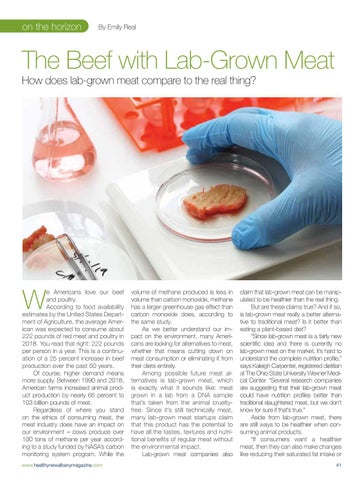on the horizon
By Emily Real
The Beef with Lab-Grown Meat How does lab-grown meat compare to the real thing?
W
e Americans love our beef and poultry. According to food availability estimates by the United States Department of Agriculture, the average American was expected to consume about 222 pounds of red meat and poultry in 2018. You read that right: 222 pounds per person in a year. This is a continuation of a 25 percent increase in beef production over the past 50 years. Of course, higher demand means more supply. Between 1990 and 2018, American farms increased animal product production by nearly 66 percent to 103 billion pounds of meat. Regardless of where you stand on the ethics of consuming meat, the meat industry does have an impact on our environment – cows produce over 100 tons of methane per year according to a study funded by NASA’s carbon monitoring system program. While the www.healthynewalbanymagazine.com
volume of methane produced is less in volume than carbon monoxide, methane has a larger greenhouse gas effect than carbon monoxide does, according to the same study. As we better understand our impact on the environment, many Americans are looking for alternatives to meat, whether that means cutting down on meat consumption or eliminating it from their diets entirely. Among possible future meat alternatives is lab-grown meat, which is exactly what it sounds like: meat grown in a lab from a DNA sample that’s taken from the animal crueltyfree. Since it’s still technically meat, many lab-grown meat startups claim that this product has the potential to have all the tastes, textures and nutritional benefits of regular meat without the environmental impact. Lab-grown meat companies also
claim that lab-grown meat can be manipulated to be healthier than the real thing. But are these claims true? And if so, is lab-grown meat really a better alternative to traditional meat? Is it better than eating a plant-based diet? “Since lab-grown meat is a fairly new scientific idea and there is currently no lab-grown meat on the market, it’s hard to understand the complete nutrition profile,” says Kaleigh Carpenter, registered dietitian at The Ohio State University Wexner Medical Center. “Several research companies are suggesting that their lab-grown meat could have nutrition profiles better than traditional slaughtered meat, but we don’t know for sure if that’s true.” Aside from lab-grown meat, there are still ways to be healthier when consuming animal products. “If consumers want a healthier meat, then they can also make changes like reducing their saturated fat intake or 41
